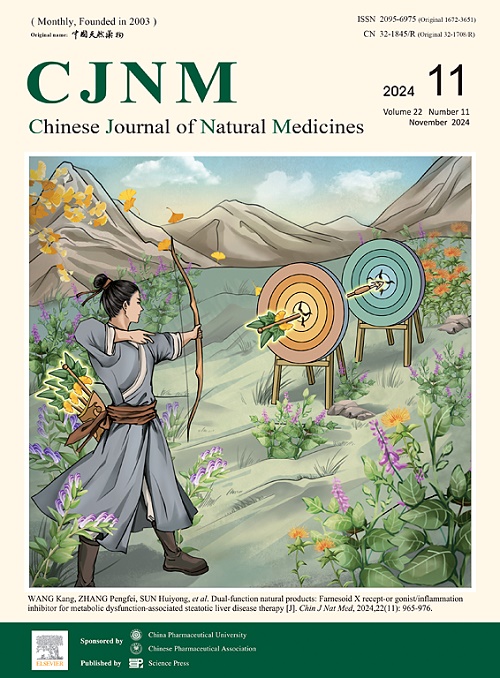木犀草素通过 Notch 信号通路减少 NCR+ILC3 的消耗,从而改善小鼠的溃疡性结肠炎
IF 4
2区 医学
Q1 INTEGRATIVE & COMPLEMENTARY MEDICINE
引用次数: 0
摘要
第3群先天性淋巴细胞(ILC3)亚群的失调,如NCR-ILC3占优势而NCR+ILC3耗竭,不利于受损肠屏障的修复,从而导致溃疡性结肠炎(UC)病程延长、病情顽固。我们之前的研究表明,叶黄素能促进NCR-ILC3分化为NCR+ILC3,从而改善UC小鼠NCR+ILC3的消耗,但其机制尚不清楚。本文旨在探讨叶黄素提高NCR+ILC3比例的内在机制。用2%的DSS建立UC小鼠模型,阻断Notch信号传导,然后用木犀草素进行干预。结果表明,随着Notch信号通路的阻断,叶黄素改善UC小鼠疾病症状(包括抑制体重下降、减轻结肠粘膜病理损伤等)的作用减弱。此外,叶黄素还能增加NCR+ILC3、NCR+MNK3和IL-22+ILC3的比例,降低肠道通透性,促进粘蛋白分泌,促进ZO-1和Occludin的表达,Notch抑制剂LY-411575中和了叶黄素的上述作用。木犀草素激活了 UC 小鼠异常受阻的 Notch 信号通路。根据分子对接预测,小鼠叶黄素与RBPJ的亲和力分别为-7.5 kcal-mol-1;叶黄素与Notch1和RBPJ的亲和力分别为-6.4 kcal-mol-1和-7.7 kcal-mol-1。这些结果证明,木犀草素可通过Notch信号转导提高NCR+ILC3的比例,为靶向NCR+ILC3恢复肠屏障功能以缓解溃疡性结肠炎提供了依据。本文章由计算机程序翻译,如有差异,请以英文原文为准。
Luteolin ameliorates ulcerative colitis in mice via reducing the depletion of NCR+ILC3 through Notch signaling pathway
The disorder of group 3 innate lymphoid cells (ILC3) subgroup, such as the predominance of NCR-ILC3 but the depletion of NCR+ILC3, is unfavorable to damaged intestinal barrier repair, which leads to the prolongations and obstinacy of ulcerative colitis (UC). Our previous studies had shown that luteolin promoted NCR−ILC3 differentitating into NCR+ILC3 to improving the depletion of NCR+ILC3 in UC mice, while the mechanism is unclear. This article aimed to explore the underlying mechanism of luteolin enhancing the proportion NCR+ILC3. UC mice model was established with 2% DSS and Notch signaling was blocked, then luteolin was used to intervene. The results showed that the effect of luteolin on ameliorating disease symptoms in UC mice, including inhibiting the weight loss, reducing the pathological damage of colon mucosa, etc., was diminished with blocking Notch signaling pathway. In addition, luteolin increased the proportion of NCR+ILC3, NCR+MNK3 and IL-22+ILC3, decreased intestinal permeability, promoted mucin secretion, and promoted ZO-1 and Occludin expression, the above effect of luteolin was neutralized by Notch inhibitor LY-411575. Luteolin activated the abnormally blocked Notch signaling pathway in UC mice. And molecular docking predicted the affinity of luteolin for RBPJ to be −7.5 kcal·mol−1 in mouse, respectively; the affinity of luteolin for Notch1 and RBPJ was respectively scored to be −6.4 kcal·mol−1 and −7.7 kcal·mol−1 homo sapiens. These results proved that luteolin is positive for enhancing the proportion of NCR+ILC3 via Notch signaling, and it provides a basis for targeting NCR+ILC3 for restoring intestinal barrier function to alleviating ulcerative colitis.
求助全文
通过发布文献求助,成功后即可免费获取论文全文。
去求助
来源期刊

Chinese Journal of Natural Medicines
INTEGRATIVE & COMPLEMENTARY MEDICINE-PHARMACOLOGY & PHARMACY
CiteScore
7.50
自引率
4.30%
发文量
2235
期刊介绍:
The Chinese Journal of Natural Medicines (CJNM), founded and sponsored in May 2003 by China Pharmaceutical University and the Chinese Pharmaceutical Association, is devoted to communication among pharmaceutical and medical scientists interested in the advancement of Traditional Chinese Medicines (TCM). CJNM publishes articles relating to a broad spectrum of bioactive natural products, leading compounds and medicines derived from Traditional Chinese Medicines (TCM).
Topics covered by the journal are: Resources of Traditional Chinese Medicines; Interaction and complexity of prescription; Natural Products Chemistry (including structure modification, semi-and total synthesis, bio-transformation); Pharmacology of natural products and prescription (including pharmacokinetics and toxicology); Pharmaceutics and Analytical Methods of natural products.
 求助内容:
求助内容: 应助结果提醒方式:
应助结果提醒方式:


